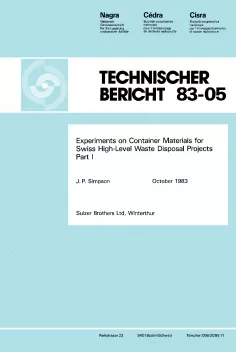
Technical Report NTB 83-05
Experiments on Container Materials for Swiss High-Level Waste Disposal Projects Part I
The present concept for final disposal of high level waste in Switzerland consists of a repository at a depth of 1'000 to 1’500 m in the granitic bedrock of northern Switzerland. The waste will be placed in a container which is required to function as a high integrity barrier for a number of years following the closure of the repository. The present report is the first of a set of two dealing with the evaluation of potential materials for such containers. The properties which determine the selection of appropriate materials are: the resistance to elevated temperatures and high levels of radiation, mechanical resistance and resistance to corrosion. A review of the available literature leads to the conclusions that polymeric materials are unsuitable primarily because of their inadequate thermal performance and that ceramic materials, in particular alumina, can present problems because of their poor or unproven fracture toughness characteristics. Metals, in view of their mechanical properties and ease of fabrication and use, are considered most likely to provide a satisfactory solution at the present time. The main difficulty lies in proving the integrity of the container for the required life (up to approx. 1'000 years) when subjected to corrosion in groundwater under repository conditions. Nodular iron, cast steel, copper, inconel 625 and Ti-Code 12 are judged to be the most promising candidates for further consideration within the Swiss programme.
A more detailed appraisal of the materials retained, in particular with respect to corrosion, identifies a number of issues insufficiently covered by the available literature. The experimental programme initiated to provide a better data base includes
- constant strain rate testing of Ti-Code 12 and copper at 80°C in solutions up to 2 mg/l O2 and up to 15 g/l Cl- at strain rates between 10-5 and 2 x 10-7 s-1;
- the effect of bentonite on the corrosion of Ti-Code 12, copper, nodular cast iron and cast steel;
- general immersion corrosion tests of welded specimens of the above four materials at temperatures up to 140°C;
- the behaviour of copper, Ti-Code 12 and Zircalloy-2 when immersed in liquid lead for times up to 500 hours under a tension equal to 80 % of their yield stress at room temperature;
- corrosion potential and galvanic current measurements on electrodes of several material pairs (Cu/cast steel, Cu/cast nodular iron, Ti-Code 12/cast steel, Ti-Code 12/cast nodular iron, Cu/Pb, Ti-Code 12/Pb) at room temperature and 140°C up to 1'000 h.
In all the experiments the corrosive medium is chosen to represent expected groundwaters at repository depths in Switzerland.
An appendix to the present report presents the first experimental results obtained. Full experimental details, results and conclusions of the work will be given in a subsequent Nagra Technical Report.
